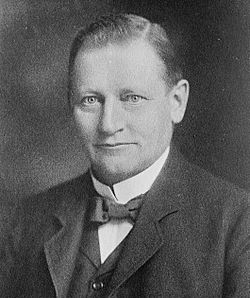Albrecht Penck facts for kids
Quick facts for kids
Albrecht Penck
|
|
|---|---|

Penck in 1911
|
|
| Born | 25 September 1858 |
| Died | 7 March 1945 (aged 86) Prague, Bohemia and Moravia, Nazi Germany
|
| Alma mater | University of Leipzig |
| Awards | Charles P. Daly Medal (1914) Vega Medal (1923) |
| Scientific career | |
| Fields | Geomorphology, Quaternary geology, climatology, political geography |
| Institutions | University of Vienna Harvard University Humboldt University |
| Doctoral advisor | Ferdinand Zirkel |
| Doctoral students | Jovan Cvijić, Johann Sölch, Eduard Brückner, Alfred Merz, Naomasa Yamasaki |
| Influences | Eduard Suess Walther Penck |
| Influenced | Julius Büdel Jovan Cvijić Walther Penck |
Albrecht Penck (born September 25, 1858 – died March 7, 1945) was an important German geographer and geologist. He was also the father of another famous geographer, Walther Penck.
About His Life
Albrecht Penck was born in Reudnitz, a town near Leipzig, Germany. He became a university professor in Vienna, Austria, from 1885 to 1906. Later, he taught in Berlin from 1906 to 1927. In Berlin, he also led the Institute and Museum for Oceanography.
Penck focused his studies on two main areas: geomorphology and climatology. Geomorphology is the study of how Earth's surface changes over time. Climatology is the study of Earth's climate. His work helped make the Vienna school of physical geography well-known around the world.
He worked with another scientist, Eduard Brückner, on a big project. They wrote a book called Die Alpen im Eiszeitalter (The Alps in the Ice Age). In this book, they identified four major Ice Ages that happened in Europe. These ice ages are named Gunz, Mindel, Riss, and Würm. They were named after river valleys where signs of these ice ages were first found.
In 1886, Penck married the sister of a successful writer from Bavaria. He passed away in Prague in 1945.
While teaching in Vienna, he taught several students who became important geographers themselves. These included Eugeniusz Romer from Poland and Stepan Rudnytsky from Ukraine.
Albrecht Penck also helped publish his son Walther's work after his son passed away. This book was called Der Morphologische Analyse and came out in 1924.
In 1928, Penck visited the University of California at Berkeley in the United States. He taught there as a guest professor.
He received many honors for his work. In 1905, he became a member of the Royal Swedish Academy of Sciences. In 1914, he was given the Founder's Medal by the Royal Geographical Society.
His Legacy
Many things are named after Albrecht Penck to remember his contributions. For example, a glacier in Svalbard, Norway, is called Penckbreen.
Since 1958, a special award called the "Albrecht-Penck-Medaille" has been given out. This medal honors people who have made great achievements in Quaternary science. Quaternary science studies the most recent period of Earth's history, including the Ice Ages.
Even an artist, Ralf Winkler, chose the name A. R. Penck in 1966 to honor him.
Some Criticisms
While Albrecht Penck's work on Earth's surface and climate is highly respected, some of his later ideas about political geography faced criticism. After World War I, he supported ideas about Germany needing more land for its people. These ideas were sometimes used to justify taking over other territories.
For example, an American geographer named Davis noted that some of Penck's statements during the war made people think less of him. After World War I, Penck continued to develop these ideas. Unfortunately, these concepts were later used by some groups in Germany to support their plans for expansion. For instance, his ideas about "German soil" were used to justify taking over parts of Poland in 1939.
His Works
- Morphologie der Erdoberfläche (Morphology of the Earth's Surface); 2 volumes, 1894
- (with Eduard Bruckner) Die Alpen im Eiszeitalter (The Alps in the Ice Age); 3 volumes, 1909
- Die Gipfelflur der Alpen (The Summit Level of the Alps) (1919)
- With geographer Eduard Richter, he edited the Atlas der Österreichischen Alpenseen (Atlas of the Austrian Alpine Lakes, 1895).
- International Map of the World
See also
 In Spanish: Albrecht Penck para niños
In Spanish: Albrecht Penck para niños

